
Everglades offers landscape views, wildlife
FLORIDA CITY, Fla. — Covering 1.5 million acres on the southwestern tip of Florida, Everglades National Park is the largest subtropical wilderness in the United States. It is also an International Biosphere Reserve, a World Heritage Site and a Wetland of International Importance.
“The Everglades once encompassed three million acres, which are now crisscrossed by 2,300 miles of canals and 2,000 miles of levees and berms,” said David Abel, former University of Miami Visiting Knight Chair and producer and director of the award-winning documentary “Gladesmen: The Last of the Sawgrass Cowboys.”
But federal and state governments are spending more than $16 billion to restore much of the historic flow of water to the Everglades.
“It’s considered the world’s most expansive ecological restoration projects,” said Abel.
| The Ernest F. Coe Visitor Center entrance near Florida City (Staff photos). | 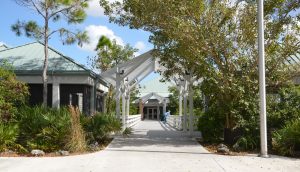 |
There are multiple entrances and routes to take to explore the park from the Gulf Coast on the west to Shark Valley on the north. The 38-mile scenic drive from the Ernest F. Coe Visitor Center near here is a gateway to several trails worth exploring. Named for the American conservationist known as the “Father of Everglades National Park,” the Coe Visitor Center offers information and a well-stocked gift shop on rare birds and other items as well as periodic films and exhibits.
There is a “Passport to Your National Parks” program where visitors can purchase a passport book and get a cancellation stamp in the visitor center or park store to capture the date and location of your visit. There is a stamp and ink pad in the Coe Visitor Center.
Four miles west from the visitor center is the Royal Palm Visitor Center, where more information can be obtained as well as ranger-led activities. The center offers staff assistance for answers to questions and general park information, a small bookstore, restrooms, water and shade for those walking Gumbo Limbo Trail and Anhinga Trail.
If you are in your own vehicle, you may want to protect it from the vultures found in the visitor area. For unknown reasons, they are attracted to the rubber around windshields, sunroofs, and windshield wipers and have been known to cause damage to vehicles. Tarps and bungee cords available free of charge in the Royal Palm parking area.
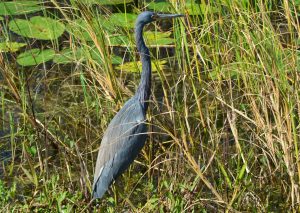 |
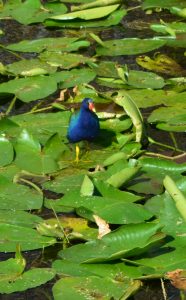 |
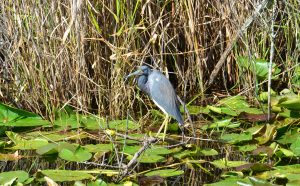 |
Colorful birds are among the most popular wildlife for visitors in winter. |
The entrance to the Anhinga Trail can be accessed from Royal Palm where birds such as cormorants and great egrets can be seen along with alligators, colorful grasshoppers, green sea and cooter turtles as well as fish such as Florida gar and largemouth bass. The boardwalk takes you over the marshes and lush vegetation with Cypress trees. The dense tropical hammock of the Gumbo Limbo Trail can also be entered from Royal Palm.
| The boardwalk along the Anhinga Trail in Everglades National Park extends over water and sawgrass prairie. | 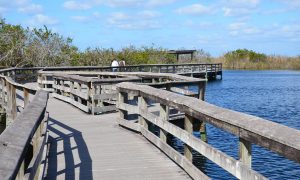 |
Juxtaposed with the vast Everglades landscape is the historic Nike Missile Site HM-69. It is one of the best-preserved relics of the 1950s in Florida and early 1960s Cold War with the former Soviet Union and remains virtually the same as it was when official use of the site ended in 1979. The remaining structures include a missile assembly building, missile shelters, barracks and a guard dog kennel. A restored Nike-Hercules missile, with warhead removed, is on display at the site.
Construction of the site by the U.S. Army Corps of Engineers was completed in 1965 after the Cuban Missile Crisis of October 1962. At the time, the nation’s air defenses were positioned to protect against a possible Soviet air attack. Located a mere 160 miles from the Cuban coast, this strategic site within Everglades National Park was chosen to build an anti-aircraft missile site.
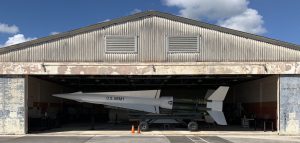 |
A Nike Hercules missile on display (Photo by Greta West). |
The Nike Hercules missile site was listed on the U.S. Department of the Interior Register of Historic Places on July 27, 2004, as a Historic District.
“I can’t even believe that something like this is here,” said Heidi, a visitor from Plano, Texas.
The potential impact a site like this would have on the environment as well as the disturbance it could cause to surrounding wildlife is enormous. The site has been inactive since the end of the Cold War and tours are available for park guests during the dry season in the months of January through April. The remaining original buildings have been converted into research centers.
| Alligators are popular among park visitors and are common at Royal Palm. | 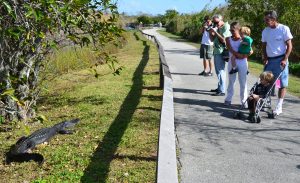 |
The ghostly Cold War-era missile site surrounded by the natural beauty of the park is still a stark reminder of how closely the atomic era and Everglades have come in contact.
The Pinelands Trail is a subtropical pine forest and has some of the most diverse habitat in South Florida. Less than half a mile long, the boardwalk, partially immersed in warm water, is easy to navigate. It is a different ecosystem and while you won’t see alligators here you are bound to see the endangered snails that inhabit the area that feed on periphyton, known as “swamp snot,” according to park ranger Jen Lopez of Miami.
The Mahogany Hammock Trail boardwalk trail meanders through a dense, jungle-like hammock. There is lush vegetation which includes gumbo-limbo trees, air plants, and the largest living mahogany tree in the United States. The boardwalk bridges the sawgrass river to the tropical hammock. The back section rises through the hammock from the dense undergrowth toward the tree canopy, where owls, air plants and dragonflies flourish.
No trip to this part of the Everglades is complete without stopping at the iconic Robert is Here Fruit Stand several miles outside the park entrance and just west of Florida City. With a dizzying array of dressing, sauces and pickles available besides its fresh fruit and homemade key lime pies, a key lime milkshake after a day of hiking is a welcome treat. The stand was started by six-year-old Robert Moehling in 1959 and is a staple of the area.
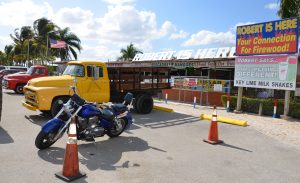 |
Part of the charm of Robert Is Here are the antique vehicles often found in front of the fruit stand near Florida City. |
While Everglades National Park can be overwhelming for visitors, with some planning, it can be a rewarding day trip from anywhere in South Florida.
If You Go
- Directions to the Ernest F. Coe Visitor Center from Miami: Take the Florida Turnpike (Route 821) south until it ends, merging with U.S. 1 at Florida City. Turn right at the first traffic light onto Palm Drive (State Road 9336/SW 344 Street) and follow the signs to the park.
- Address: 40001 State Road 9336, Homestead, Fla.
- Entrance Fees: Per vehicle – $30, good for seven consecutive days starting from the day of purchase. Per person/cyclist – $15, good for seven consecutive days starting from the day of purchase. Annual pass: $55, valid for 12 months starting from the day of purchase and is good for unlimited visits to the park during this period. Free admission on certain announced holidays. See website for details: http://nps.gov/ever.
- Hours: 9 a.m. – 5 p.m. (mid-April through mid-December); 8 a.m. – 5 p.m. (mid-December through mid-April).
- Phone: 305-242-7700.
- Robert is Here address: 19200 S.W. 344th St., Florida City, Fla. 33034; Phone: 305-246-1592; Web site: http://www.robertishere.com.

Comments are Closed